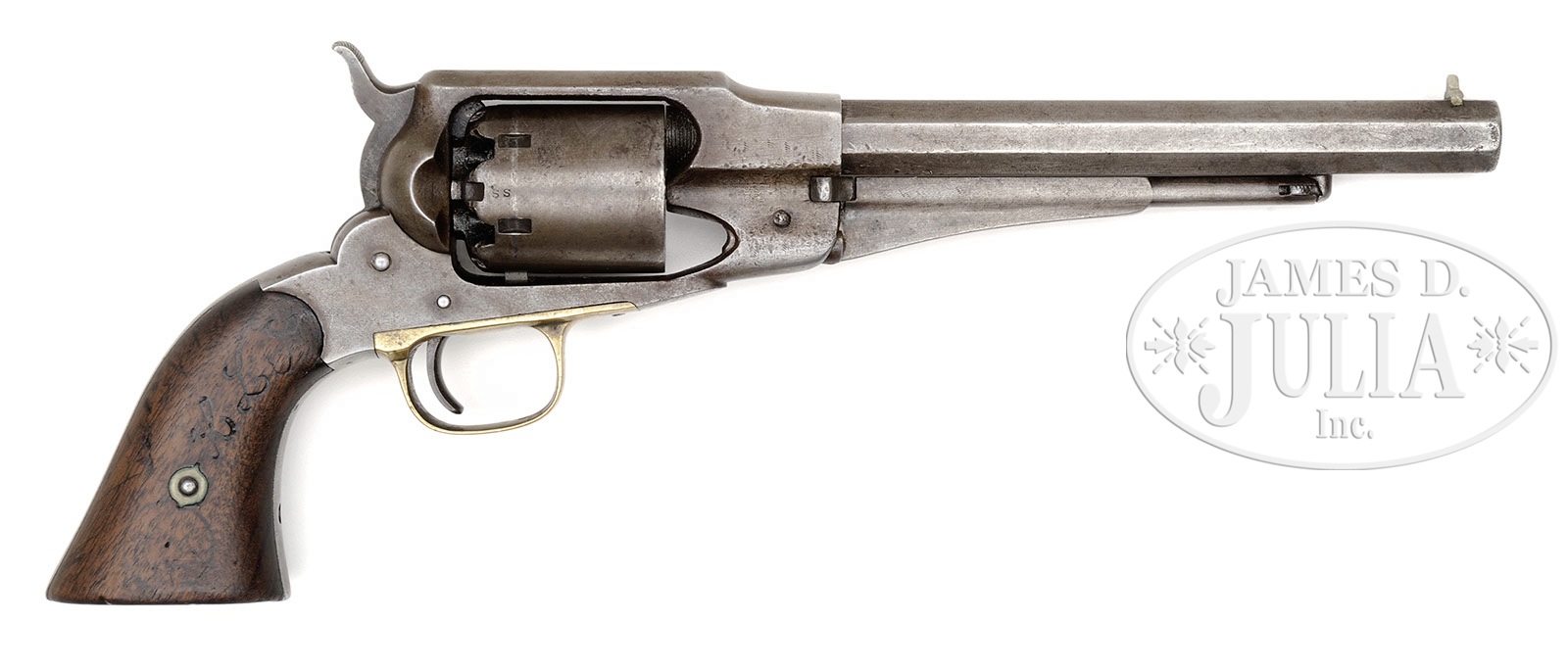| Image | Lot | Price | Description |
|
2243
|
$13,800.00
|
REMINGTON MODEL 1861 ARMY PERCUSSION REVOLVER PURPORTED TO HAVE BELONGED TO A SURVIVOR OF CUSTER’S LITTLE BIG HORN BATTLE AND CAPTURED BY CHIEF RAIN-IN-THE-FACE.SN 11208. Cal 44. Usual configuration with 8″ oct bbl, narrow dovetailed German silver front sight and 2-line address. Mounted with 2-pc smooth walnut grips that show the outline of an inspector’s cartouche on the left side. Right grip has the hand carved initials “CLS” and also a large circle with the outline of a buffalo head. Left grip has another circle surrounding the cartouche and what may be a small eagle. Consignor states that in 1992 he was rebuilding a dam on the Standing Rock Reservation in South Dakota after a flood had destroyed the old dam and washed away part of the Episcopal Cemetery, including the grave of Rain-In-The-Face. One of his employees, a descendant of Bernard Crow-Ghost, a son of Rain-In-The-Face apparently related many stories to consignor, one of which was how Rain-In-The-Face had found a gray horse at the Custer battle with saddle bags that contained a revolver. Rain-In-The-Face was known to have marked his weapons with his “life-mark” which include the sun, the eagle, buffalo head and sometimes bear paws. In addition to the markings on the grips, the muzzle is also filed flat which is common practice among the Indians to mark their weapons with their “lemita”, a form of ownership. The initials “CLS” are believed to have belonged to saddler Claus L. Schlieper who was with the 7th Cavalry at the Little Big horn and assigned to Company F with the pack train and is so listed on page 169 of The Little Big Horn, 1876, Overfield. As is well recorded, the pack train lagged behind the Custer and Reno forces and during the battle joined with Reno for the remainder of the fight on Reno Hill. Consignor relates that the family of James N. Rooney related to him that their grandfather (Rooney) has also been with Company F and the pack train. He had told the story of how he shot a Sioux warrior who had tried to take Schlieper’s horse but the horse escaped and ran toward the river. Schlieper reportedly told Rooney that he hoped he could find his horse because his “orig enlistment-issued Remington revolver was still in his saddle bags”. Rooney also survived the battle and eventually settled in Sturgis and worked for the quartermaster department until 1911 and died in 1918. The Rooney family still lives in the Sturgis area. Schlieper joined the “new” 7th Cavalry at Fort Riley, KS on Dec 17, 1866 under Lt. Col. George Custer. It is well recorded that as far back as the Civil War Custer required his troops to mark their individual weapons to prevent theft, a practice he carried forward into the “new” 7th Cavalry. It is also well recorded that Company F rode gray horses. PROVENANCE: Wendell Grangaard Collection. CONDITION: Fair to good. No orig finish remains with the metal being an overall smooth gray/brown patina with light pitting around front part of the frame; grips are sound showing heavy wear with a smooth hand-worn patina. Mechanics are fine, strong dark bore. 4-49322 JR529 (15,000-25,000) – Lot 2243
Auction: Firearms - Spring 2014 Please Note: All prices include the hammer price plus the buyer’s premium, which is paid by the buyer as part of the purchase price. The prices noted here after the auction are considered unofficial and do not become official until after the 46th day. |






